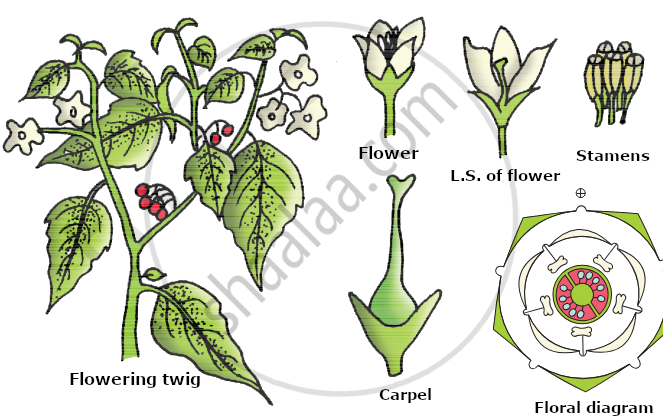Advertisements
Advertisements
Question
Take one flower each of families Fabaceae and Solanaceae and write its semi-technical description. Also, draw their floral diagrams after studying them.
Solution 1
Family Fabaceae (e.g., Pisum sativum) Systematic position:
Class - Dicotyledoneae
Subclass - Polypetalae
Series - Calyciflorae
Order - Rosales
Family - Fabaceae
Vegetative characters:
Habit: herb.
Root: tap, branched, with root nodules.
Stem: herbaceous, climbing.
Leaves: pinnately compound, leaf base pulvinate, stipulate, venation reticulate.
Floral characters:
Inflorescence: racemose.
Flower: bisexual, zygomorphic, irregular, hermaphrodite, white or pink, complete, hypogynous to perigynous.
Calyx: sepals five, gamosepalous, ascending, imbricate aestivation, campanulate calyx tube.
Corolla: five, polypetalous, vexillary aestivation, papilionaceous, consisting of a posterior standard or vexillum, two lateral wings or alae, and two anterior ones forming a keel.
Androecium: 10 stamens in two bundles (diadelphous) of (9) + 1, anthers dithecous (bilobed), basifixed, introrse.
Gynoecium: ovary superior, monocarpellary, unilocular with many ovules, marginal placentation, style bent and long, stigma simple and hairy.
Fruit: legume; seeds one to many, non- endospermic
Floral formula :


Floral Diagram of Pisum sativum
Solution 2
Family solanaceae
The common plant of the family Solanaceae is Solanum nigrum (Makoy). It is a wild herb that grows spontaneously in potato and tomato fields.
habitat and temperament Wild, annual herbaceous plant.
(i) Origin: Branched taproot: root system.
(ii) Pillar: Aerial, herbaceous, cylindrical, branched, smooth, green.

Makoy (different parts of Solanum nigrum plant, flower and its components, flower pictures)
(iii) Leaf: Columnar and branched, alternate, simple, non-branching, unilocular reticulate.
(iv) Inflorescence: Solitary, axillary or cymose as in Solanum
(v) Flowers: Non-cotyledonous, petiolate, complete, bisexual, radially symmetric, punctate, hypogynous, small and white.
(vi) Calyx: sepals five, united, persistent, valvate aestivation
(vii) Cluster: 5 Joint group, ring-shaped, or twisted group configuration.
(viii) Poumang: 5 attached stamens, arranged alternately in groups, introverted, anthers long and bilobed, tips short. Dehiscence in pollen through anterior pores.
(ix) Gynoecium: bicarpellary, obligately placed, syncarpous; ovary superior, bilocular, placenta swollen with many ovules, axile
(x) Fruit: Saras, berry.
Flower formula -

APPEARS IN
RELATED QUESTIONS
Define the following term:
Superior ovary
Write the floral formula of an actinomorphic bisexual, hypogynous flower with five united sepals, five free petals. Five free stamens and two united carpals with superior ovary and axile placentation.
Floral formula presents ______.
An aspect of flower shown in floral formula but not in floral diagram is
